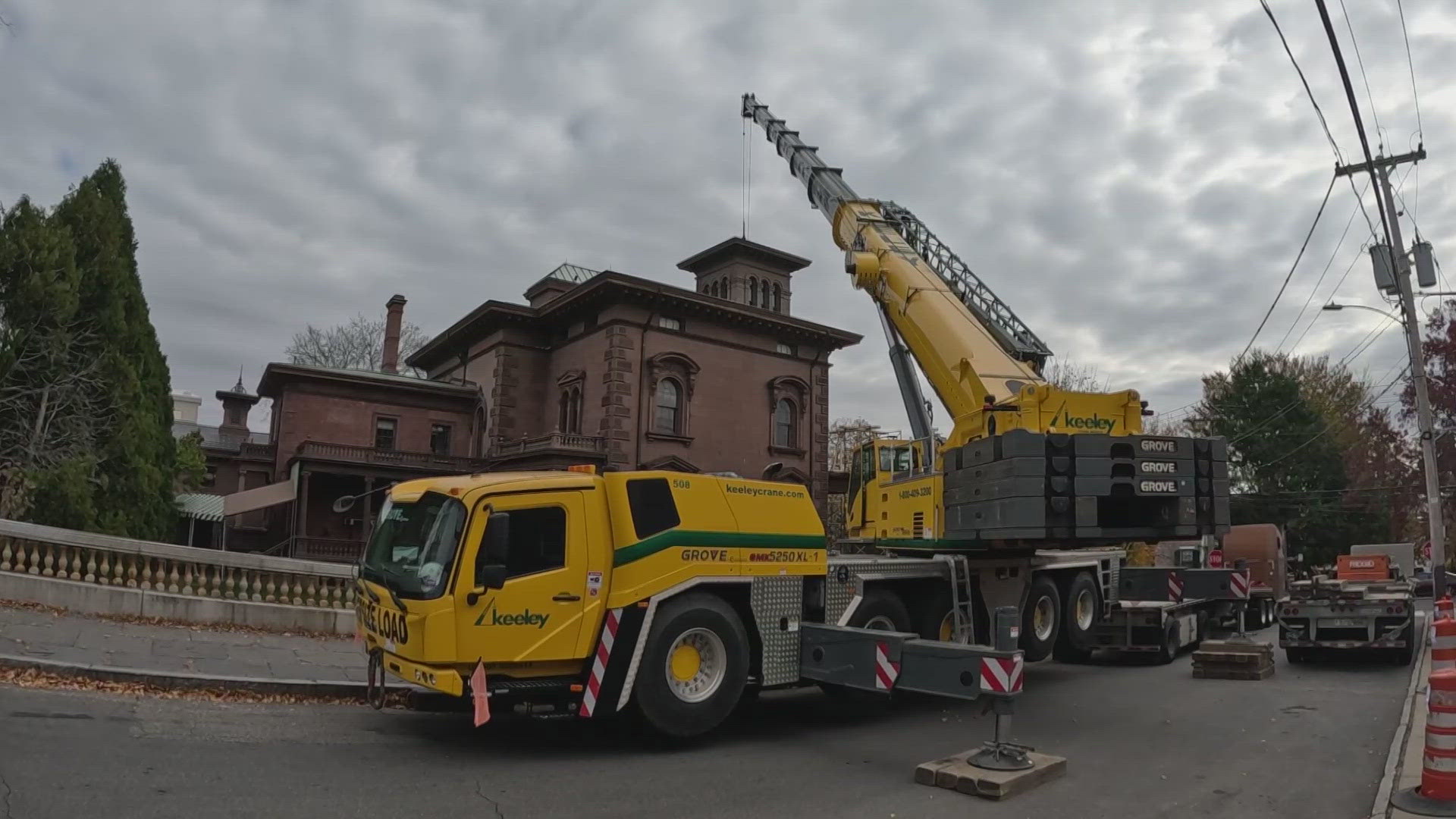PORTLAND, Maine — Just standing on the sidewalk of Portland’s Danforth Street, the Victoria Mansion stands out.
The wide walkway, which is brick or asphalt on the rest of the street, is built of what appear to be large, rectangular slabs of stone across the front of the mansion and up the side street. The elegant stone wall with steel balusters wraps around the mansion, as well. All of it, including the stone-paved drive way, sets the mansion apart from anything else in the historic neighborhood.
On this day, the elegance was interrupted by the boom of a huge crane, jetting skyward above the mansion, lifting a 10,000 pound section of brownstone from the front of the mansion.
“We’ve been planning this for ten years,” said Tim Brosnihan, executive director of the Victoria Mansion, which has been a museum for the last 80 years.
The 160-year-old house is built of brownstone, which Brosnihan said can begin to deteriorate after a century or so of exposure.
“So this is the piece right at the base of the structure, right at ground level,” Brosnihan explained as masons and the crane crew carefully guided the huge piece of stone across the front lawn to a waiting flatbed truck.
Brosnihan admitted to a sigh of relief when the stone was finally on the truck. Other, smaller pieces followed until there was a full load.
“A complicated project," he explained of rebuilding the brownstone exterior structure of the large bay window area. “We have to protect the precious interiors of this house but still replace the stone.”
Inside, literally inches away from the reconstruction work, is the mansion’s “reception room," one of the most ornate in the old house. The room is adorned with highly detailed, hand painted plaster walls and ceiling, some of it in the Trompe l’oeil technique that literally fools the eye into thinking one is looking at a three dimensional structure, which in reality is flat.
The room also features lush and intricately woven carpeting, Victorian-era furniture and ornate wooden moldings and trim, adorned with gold leaf.
Similar features are found across the hall in the front parlor. Both rooms presumably designed to impress visitors.
“I still remember the first impression when you come in through the vestibule and look up,” the executive director said, “and it just sort of takes your breath away. There is not another house quite like this, I would say, in the country."
The Victoria Mansion was finished in 1860, built for Maine natives Ruggles and Olive Morse. They had moved to New Orleans, where Morse made his fortune in the hotel business before the Civil War. In 1858, they began building the mansion in Portland for a summer home.
Brosnihan said it was one of the rare homes at that time with central heat, running water, flush toilets and gas lights. That dramatic entry, soaring up to a huge, stained glass skylight.
There is no record of what it cost to build the house. However, some of that money came from a darker side of Morse’s life: his involvement with slavery.
“There were at least 27 individuals they enslaved in New Orleans,” Brosnihan said, adding that there seems no question the Victoria Mansion was funded, in part, by the work of slaves.
“I think our role as preservers of history is to present the facts as they are. And we can think about our collective past and contemplate what that all means. But I don’t think it's something to shy away from or hide. We have to confront the past as it was.”
They tell that story, at least what is known of it, as part of sharing the larger story of the mansion with the many visitors who tour it each year.
“Tens of thousands a year,” said the director.
And the staff of the mansion focus on the constant work of preserving the historic building. That includes the current brownstone replacement, which is budgeted to cost more than $1 million, and for which they needed to raise money through grants and donations.
It also includes much smaller, but no less important projects, such as restoring the intricate wall and ceiling painting that has played a role in making the Victoria Mansion a National Historic Landmark.
Paint conservator Corrine Long said she has been working on that project since 2017, though not full time. Using small artist brushes and her own formulas, she is carefully cleaning the walls and paintings. The difference can be striking, after more than a century of grime and old coal dust, which darkened the walls, are cleaned away to make the surfaces and their artwork shine brightly again.
Long, who also restores paintings in Boston, said there is still lots of that work to be done.
"Because this museum is so heavily painted, its like entering a painting. When you come through here, there is almost no end to the walls that need to be cleaned and conserved."
It is work she, and the staff at the mansion, care deeply about. Brosnihan said they all know the mansion is a treasure from the country’s architectural past, a relic of a time that is long gone.
“People didn’t tend to preserve buildings like this, so this is an absolute unique survivor.”
NOTE: The Victoria Mansion’s annual, and very popular holiday decorations display will open Nov. 29.

